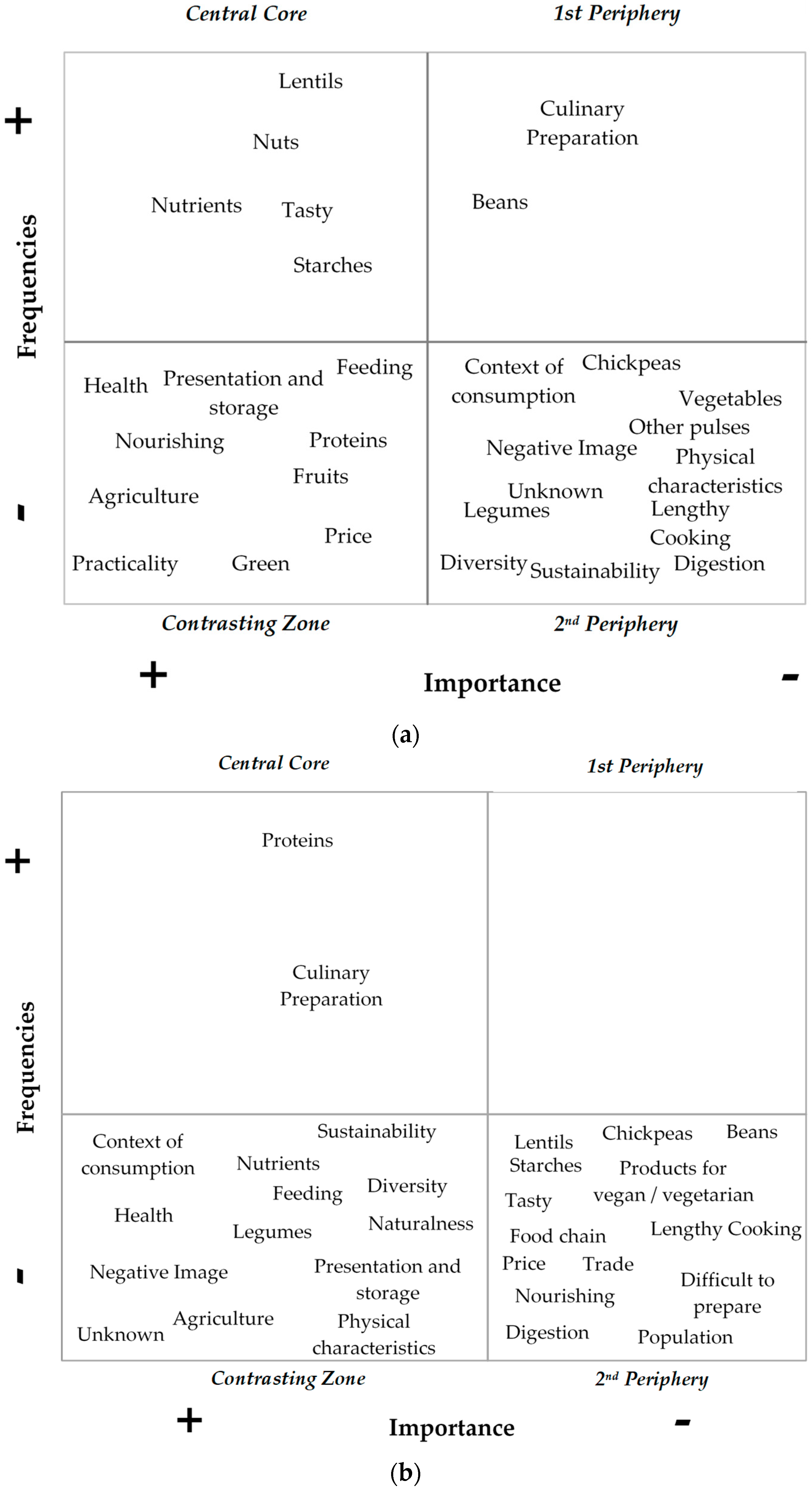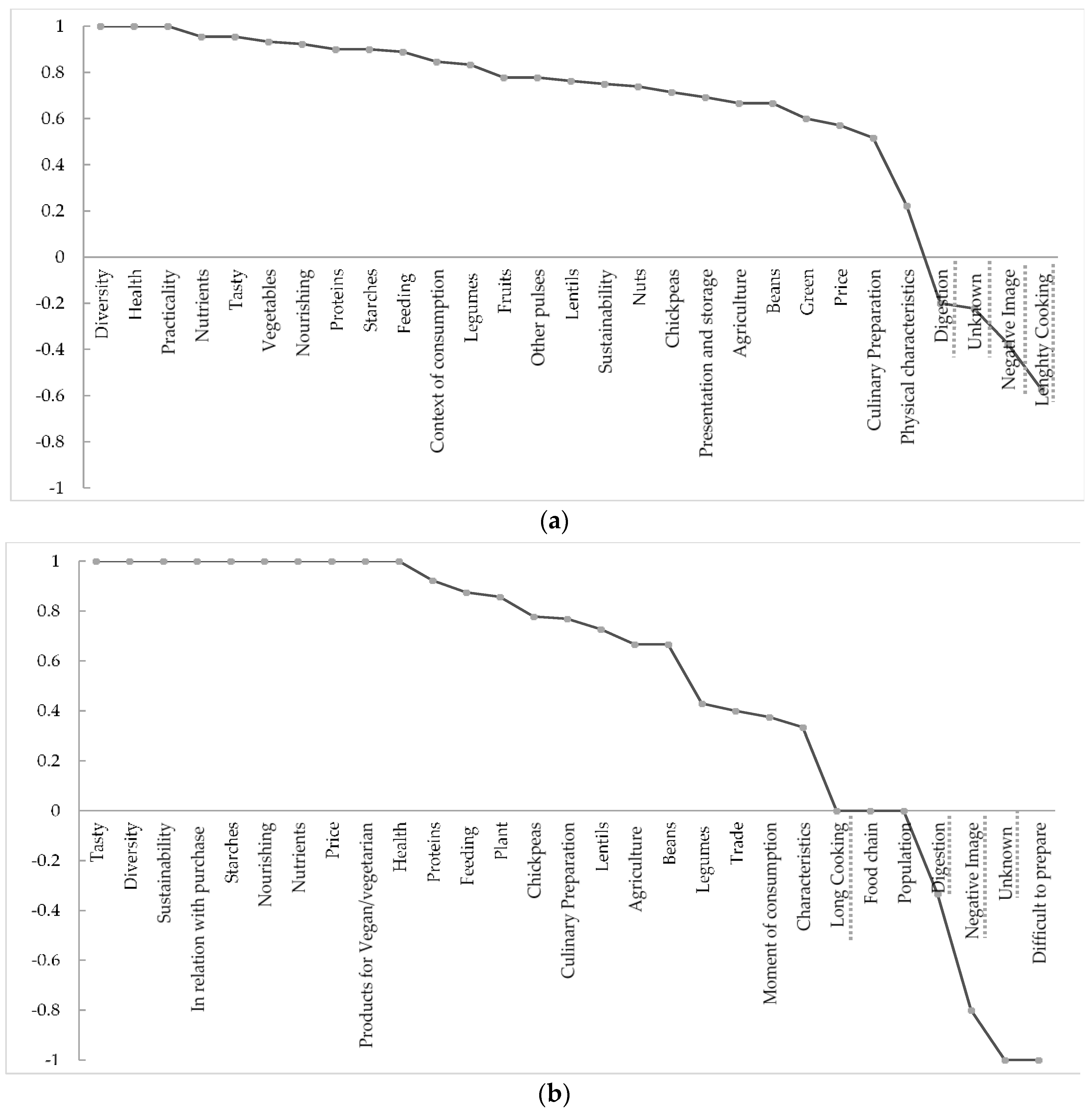Do French Consumers Have the Same Social Representations of Pulses as Food Industry Professionals?
Abstract
1. Introduction
2. Materials and Methods
2.1. Participants
2.2. Procedure
2.3. Analysis
2.3.1. Structural Approach
- The first zone is the central core, with the most frequently cited and most important word groups.
- The second zone is the first periphery, where the most frequently cited but less important word groups are found.
- The third zone is the contrasting zone, containing word groups with low citation frequency but higher importance.
- The fourth zone is the second periphery, containing low frequency word groups that were considered less important.
2.3.2. Polarity Index
3. Results
3.1. Structural Approach
3.1.1. Social Representation Map for Consumers
3.1.2. Social Representation Map for Professionals
3.2. Polarity Index
4. Discussion
4.1. What is the social Representation of Pulses among French Nonvegetarian Consumers?
4.2. What Is the Social Representation of Pulses among Pulse Industry Professionals in France?
4.3. Discrepancies between the Representations of Consumers and Professionals
4.4. What Could Be Done to Improve Communication about Pulses?
4.5. Strengths and Limitations
5. Conclusions
Author Contributions
Funding
Acknowledgments
Conflicts of Interest
References
- FAO. Que sont les légumineuses? In Légumineuses: Des Graines Nutritives Pour un Avenir Durable; FAO: Rome, Italy, 2016; ISBN 978-92-5-209463-0. [Google Scholar]
- Rio, C. Les légumes secs, aliments de choix à valoriser. Cahiers de Nutrition et de Diététique 2017, 52, 71–77. (In French) [Google Scholar] [CrossRef]
- Lecerf, J.-M. Le génie des légumineuses. Pratiques en Nutrition 2016, 12, 36–39. (In French) [Google Scholar] [CrossRef]
- ANSES INCA 3: Evolution des Habitudes et Modes de Consommation, de Nouveaux Enjeux en Matière de Sécurité Sanitaire et de Nutrition. 2017. Available online: https://www.anses.fr/fr/system/files/NUT2014SA0234Ra.pdf (accessed on 12 August 2019).
- Gueguen, J.; Duc, G. La filière Protéagineuse: Quels Défis; Quae: Versailles, France, 2008; ISBN 978-2-7592-0072-6. [Google Scholar]
- Champ, M.; Magrini, M.B.; Simon, N.; Le Guillou, C. Les légumineuses pour l’alimentation humaine: Apport nutritionnels et effets santé, usages et perspectives. In Les légumineuses pour des systèmes agricoles et alimentaires durables; Schneider, A., Ed.; Éditions Quae: Versailles, France, 2015; ISBN 978-2-7592-2334-3. [Google Scholar]
- Magrini, M.-B.; Anton, M.; Chardigny, J.-M.; Duc, G.; Duru, M.; Jeuffroy, M.-H.; Meynard, J.-M.; Micard, V.; Walrand, S. Pulses for Sustainability: Breaking Agriculture and Food Sectors Out of Lock-In. Front. Sustain. Food Syst. 2018, 2, 64. [Google Scholar] [CrossRef]
- PNNS. Programme National Nutrition Santé 2019–2023; Ministre des Solidarités et de la Santé: Paris, France, 2019; p. 94.
- Melendrez-Ruiz, J.; Buatois, Q.; Chambaron, S.; Monnery-Patris, S.; Arvisenet, G. French consumers know the benefits of pulses, but do not choose them: An exploratory study combining indirect and direct approaches. Appetite 2019, 141, 104311. [Google Scholar] [CrossRef] [PubMed]
- Gallen, C. Le rôle des représentations mentales dans le processus de choix, une approche pluridisciplinaire appliquée au cas des produits alimentaires. Recherche et Applications en Marketing 2005, 20, 59–76. (in French). [Google Scholar] [CrossRef]
- Melendrez-Ruiz, J.; Chambaron, S.; Buatois, Q.; Monnery-Patris, S.; Arvisenet, G. A central place for meat, but what about pulses? Studying French consumers’ representations of main dish structure, using an indirect approach. Food Res. Int. 2019, 123, 790–800. [Google Scholar] [CrossRef] [PubMed]
- Poquet, D.; Chambaron-Ginhac, S.; Issanchou, S.; Monnery-Patris, S. Interroger les représentations sociales afin d’identifier des leviers en faveur d’un rééquilibrage entre protéines animales et végétales: Approche psychosociale. Cahiers de Nutrition et de Diététique 2017, 52, 193–201. (in French). [Google Scholar] [CrossRef]
- Abric, J.-C. Pratiques Sociales et Représentations; Presses Universitaires de France: Paris, France, 2011; ISBN 978-2-13-059296-9. [Google Scholar]
- Rodrigues, H.; Ballester, J.; Saenz-Navajas, M.P.; Valentin, D. Structural approach of social representation: Application to the concept of wine minerality in experts and consumers. Food Qual. Prefer. 2015, 46, 166–172. [Google Scholar] [CrossRef]
- Kooijmans, A.; Flores-Palacios, F. Is eating science or common sense? Knowledge about “natural foods” among self-identified “natural food” consumers, vendors and producers in rural and urban Mexico. Appetite 2014, 81, 37–43. [Google Scholar] [CrossRef] [PubMed]
- Mercedes, C.; Mercado, P.; Idaly, B. Social Representations Associated to Hedonic Food Intake in Restaurants. Revista Latioamericana de Psicologia 2011, 43, 487–496. (in Spanish). [Google Scholar]
- Rodrigues, H.; Cielo, D.P.; Goméz-Corona, C.; Silveira, A.A.S.; Marchesan, T.A.; Galmarini, M.V.; Richards, N.S.P.S. Eating flowers? Exploring attitudes and consumers’ representation of edible flowers. Food Res. Int. 2017, 100, 227–234. [Google Scholar] [CrossRef] [PubMed]
- Bäckström, A.; Pirttilä-Backman, A.-M.; Tuorila, H. Dimensions of novelty: A social representation approach to new foods. Appetite 2003, 40, 299–307. [Google Scholar] [CrossRef]
- Lea, E.; Worsley, A.; Crawford, D. Food industry awareness of consumers’ plant food beliefs. Br. Food J. 2005, 107, 556–571. [Google Scholar] [CrossRef]
- Moliner, P.; Lo Monaco, G. Méthodes D’association Verbale Pour les Sciences Humaines et Sociales: Fondements Conceptuels et Aspects Pratiques; PUG: Grenoble, France, 2017; ISBN 978-2-7061-2695-6. [Google Scholar]
- De Rosa, A.S. The “associative network”. A technique for detecting structure, contents, polarity and stereotyping indexes of the semantic fields. Eur. Rev. Appl. Psychol. 2002, 52, 181–200. [Google Scholar]
- Schifferstein, H. Effects of product beliefs on product perception and liking. In Food, People and Society: A European Perspective of Consumers’ Food Choices; Frewer, L.J., Risvik, E., Schifferstein, H., Eds.; Springer: Berlin/Heidelberg, Germany, 2001; ISBN 978-3-662-04601-2. [Google Scholar]
- Engel, J.F.; Blackwell, R.D.; Miniard, P.W. Consumer Behavior, 6th ed.; Dryden Press: Chicago, IL, USA, 1990; ISBN 978-0-03-022979-4. [Google Scholar]
- Petty, R.E.; Briñol, P.; DeMarree, K.G. The Meta–Cognitive Model (MCM) of Attitudes: Implications for Attitude Measurement, Change, and Strength. Soc. Cogn. 2007, 25, 657–686. [Google Scholar] [CrossRef]
- Bukeviciute, L.; Dierx, A.H.; Ilzkovitz, F. The Functioning of the Food Supply Chain and Its Effect on Food Prices in the European Union; European economy Occasional papers; European Commission, Directorate-General for Economic and Financial Affairs, Publications: Brussels, Belgium, 2009; ISBN 978-92-79-11261-4. [Google Scholar]
- Van der Vorst, J.G.A.J.; Da Silva, C.A.; Trienekens, J.H. Agro-industrial Supply Chain Management: Concepts and Applications; FAO: Rome, Italy, 2007; ISBN 978-92-5-105831-2. [Google Scholar]
- Braun, V.; Clarke, V. Using thematic analysis in psychology. Qual. Res. Psychol. 2006, 3, 77–101. [Google Scholar] [CrossRef]
- Abric, J.-C. La recherche du noyau central et de la zone muette des représentations sociales. In Méthodes D’étude des Représentations Sociales; ERES, “Hors collection”: Toulouse, France, 2005; pp. 59–80. ISBN 978-2-7492-0123-8. (In French) [Google Scholar]
- Abric, J.-C. La recherche du noyau central et de la zone muette des représentations sociales. In Méthodes d’étude des représentations sociales; Abric, J.-C., Ed.; Erès: Ramonville Saint-Agne, France, 2003; pp. 59–80. ISBN 978-2-7492-0123-8. (In French) [Google Scholar]
- PNNS. The French National Nutrition and Health Program 2011–2015. Available online: https://solidarites-sante.gouv.fr/IMG/pdf/PNNS_UK_INDD_V2.pdf (accessed on 25 October 2019).
- Curran, J. The nutritional value and health benefits of pulses in relation to obesity, diabetes, heart disease and cancer. Br. J. Nutr. 2012, 108, S1–S2. [Google Scholar] [CrossRef] [PubMed]
- Rodrigues, H.; Otterbring, T. Métodos de psicología en los estudios con consumidores: Psicología social & cognitiva. In Introducción al Análisis Sensorial y Estudios con Consumidores: Nuevas Perspectivas; XOC ESTUDIO: Ciudad de Mexico, Mexico, 2019; pp. 435–465. ISBN 978-607-98549-0-4. (In French) [Google Scholar]
- Magrini, M.-B. Les Légumes secs en France. Les Légumes secs, Quels Développements Possibles à L’échelle des Territoires? Rapport Synthèse des Débats—Journée D’échanges Organisée par le Réseau Action Climat et Solagro au Ministère de L’environnement, de L’énergie et de la mer. 2016. Available online: https://solagro.org/images/imagesCK/files/publications/f78_actes_-legumes-secs-2016.pdf (accessed on 7 August 2019).


| Word Group | Professionals (n = 35) | Consumers (n = 80) | Examples of Words Proposed by Participants | |
|---|---|---|---|---|
| Agriculture (Agriculture) | 3 | 9 | water, pesticide, planting, garden, seed | |
| Beans (Haricots) | 4 | 27 | beans, white beans, dried beans | |
| Chickpeas (Pois Chiches) | 9 | 14 | chickpeas | |
| Context of consumption (Contexte de consommation) | 8 | 13 | childhood, family dish, winter, sharing, meal, restaurant, sport | |
| Culinary Preparation (Préparation culinaire) | 13 | 31 | pressure-cooker, cooker, dish, dip, steam, recipe | |
| Difficult to prepare (Préparation difficile) | 2 | 0 | hard to cook | |
| Digestion (Digestion) | 3 | 5 | digestion, gas | |
| Diversity (Diversité) | 10 | 4 | diversity, variety | |
| Feeding (Alimentation) | 8 | 18 | food, eat, feeding | |
| Food chain (Filière profesionnelle) | 4 | 0 | profession, sector, competitively | |
| Fruits (Fruits frais) | 0 | 9 | apricots, bananas, grapes | |
| Green (Vert) | 0 | 5 | green | |
| Health (Santé) | 8 | 17 | beneficial, healthy | |
| Legumes (Légumineuses) | 7 | 6 | legumes, soya beans | |
| Lentils (Lentilles) | 11 | 38 | lentils, red lentils | |
| Lengthy Cooking (Cuisson longue) | 1 | 7 | lengthy preparation, lengthy cooking | |
| Naturalness (Naturalité) | 7 | 0 | plant-based, natural | |
| Negative Image (Image négative) | 5 | 8 | not good, insipid, not very popular, unattractive, not tasty | |
| Nourishing (Nourrisant) | 1 | 13 | appetite, energy, satiating, calorie | |
| Nutrients (Nutriments) | 9 | 22 | iron, nutritive, high in fiber, vitamins, balanced | |
| Nuts (Fruits secs) | 0 | 23 | almond, peanut, hazelnut, nut, pistachio | |
| Other pulses (Autres légumes secs) | 0 | 9 | split peas, flageolet beans | |
| Physical characteristics (Caractéristiques physiques) | 3 | 9 | brown, old, dehydrated, dry, solid | |
| Population (Population) | 1 | 0 | population | |
| Practicality (Practicité) | 0 | 5 | speed, flexibility, ease of preparation | |
| Presentation and storage (Présentation et conservation) | 2 | 13 | nonperishable, box, canned, convenient | |
| Price (Prix) | 3 | 7 | cost, economical, affordable | |
| Products for Vegans/Vegetarians (Produits vegan/végétarien) | 3 | 0 | vegan, vegetarian | |
| Proteins (Protéines) | 26 | 10 | proteins | |
| Starches (Féculents) | 3 | 20 | wheat, bulgur, potato, rice, quinoa | |
| Sustainability (Durabilité) | 11 | 5 | organic, environment, sustainable agriculture | |
| Tasty (Bon) | 4 | 22 | good, taste, flavor, delicious, fun | |
| Trade (Commerce) | 5 | 0 | import, worldwide, Italy, France | |
| Unknown (Inconnu) | 1 | 9 | little known, unknown | |
| Vegetables (Légumes) | 0 | 15 | carrots, spinach, green beans, salad | |
| Total | 175 | 393 * | ||
© 2020 by the authors. Licensee MDPI, Basel, Switzerland. This article is an open access article distributed under the terms and conditions of the Creative Commons Attribution (CC BY) license (http://creativecommons.org/licenses/by/4.0/).
Share and Cite
Melendrez-Ruiz, J.; Arvisenet, G.; Laugel, V.; Chambaron, S.; Monnery-Patris, S. Do French Consumers Have the Same Social Representations of Pulses as Food Industry Professionals? Foods 2020, 9, 147. https://doi.org/10.3390/foods9020147
Melendrez-Ruiz J, Arvisenet G, Laugel V, Chambaron S, Monnery-Patris S. Do French Consumers Have the Same Social Representations of Pulses as Food Industry Professionals? Foods. 2020; 9(2):147. https://doi.org/10.3390/foods9020147
Chicago/Turabian StyleMelendrez-Ruiz, Juliana, Gaëlle Arvisenet, Vincent Laugel, Stéphanie Chambaron, and Sandrine Monnery-Patris. 2020. "Do French Consumers Have the Same Social Representations of Pulses as Food Industry Professionals?" Foods 9, no. 2: 147. https://doi.org/10.3390/foods9020147
APA StyleMelendrez-Ruiz, J., Arvisenet, G., Laugel, V., Chambaron, S., & Monnery-Patris, S. (2020). Do French Consumers Have the Same Social Representations of Pulses as Food Industry Professionals? Foods, 9(2), 147. https://doi.org/10.3390/foods9020147






